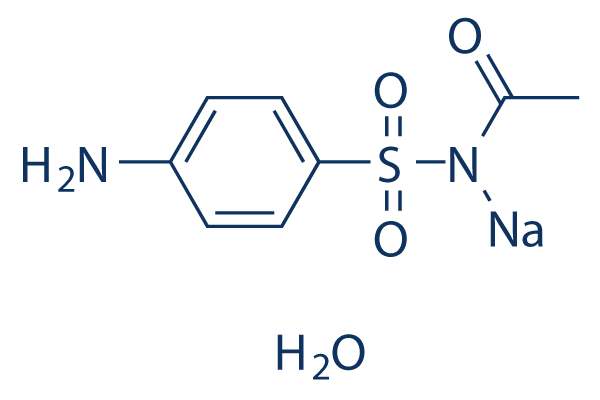|
受注:045-509-1970 |
技術サポート:tech@selleck.co.jp 平日9:00〜18:00 1営業日以内にご連絡を差し上げます |
化学情報

|
Synonyms | N/A | Storage (From the date of receipt) |
3 years -20°C powder 1 years -80°C in solvent |
|||
| 化学式 | C8H9N2O3S.H2O.Na |
||||||
| 分子量 | 254.24 | CAS No. | 6209-17-2 | ||||
| Solubility (25°C)* | 体外 | DMSO (warmed with 50ºC water bath) | 50 mg/mL (196.66 mM) | ||||
| Water | 50 mg/mL (196.66 mM) | ||||||
| Ethanol (warmed with 50ºC water bath) | 2 mg/mL (7.86 mM) | ||||||
| 体内 (毎回新しく調製した物を用意してください) |
|
||||||
|
* <1 mg/ml means slightly soluble or insoluble. * Please note that Selleck tests the solubility of all compounds in-house, and the actual solubility may differ slightly from published values. This is normal and is due to slight batch-to-batch variations. |
|||||||
溶剤液(一定の濃度)を調合する
生物活性
| 製品説明 | Sulfacetamide is a sulfonamide antibiotic that blocks the synthesis of dihydrofolic acid by inhibiting the enzyme dihydropteroate synthase(DHPS) with IC50 of 9.5 μM. Sulfacetamide is a competitive inhibitor of bacterial para-aminobenzoic acid (PABA), which is required for bacterial synthesis of folic acid. |
|---|---|
| in vitro | Sulfacetamide inhibits Arabidopsis DHPS with IC50 of 9.5 μM, pKa=5.4[1]. Sulfacetamide induces anti-proliferative effects on T-47D cells and it is independent of apoptosis and cell cycle arrest. Sulfacetamide treatment lowers expression of p53/DRAM pathway in parallel with upregulation of Akt/mTOR pathway promoting cytoprotective autophagy. The LD50 of sulfacetamide in T-47D cells after 48 h is 41 mM. Sulfacetamide does not cause DNA fragmentation. In cells treated with sulfacetamide, the ATG5 expression level increases suggesting an increase in autophagosome formation in the autophagy pathway. Autophagy induction in the sulfathiazole and sulfacetamide treatments is not accompanied by apoptosis and occurred without any distinctive arrest in a phase of the cell cycle. It triggers autophagy in T-47D cells via a DAPK independent pathway[2]. Sodium sulfacetamide or sulfacetamide is a bacteriostatic agent that is active against sulfonamide-sensitive Gramnegative and Gram-positive bacteria, including Streptococci, Staphylococci, E. coli, Klebsiella pneumoniae, Pseudomonas pyocyanea, Salmonella spp., Proteus vulgaris, and Nocardia, which are usually isolated in secondary infections of the skin. Sulfacetamide inhibits mannose-6-phosphate isomerase (also known as phosphomannose isomerase (PMI)), which is considered the key enzyme in kinetoplastid energy metabolism[3]. |
| in vivo | The LD50 of sulfacetamide for mice is 16,500 mg/kg by the oral route. In humans, the side effects include erythema, moderate swelling, nausea, vomiting, and headache. In addition to these side effects, the occurrence of StevensJohnson syndrome is reported in HIV-positive patients who received sulfacetamide drops for eye infections. All of these side effects, however, are associated with oral administration or high drug absorption through the skin, mucous membranes, and the conjunctiva, whereas topical use is not associated with strong side effects. |
プロトコル(参考用のみ)
| 細胞アッセイ | 細胞株 | human breast cancer T-47D cells |
|---|---|---|
| 濃度 | 0.0-50 mM | |
| 反応時間 | 24, 48 and 72 h | |
| 実験の流れ | Cells are cultured in RPMI medium 1640, supplemented with 10% FBS and 1% penicillin/streptomycin, in a humidified atmosphere of 5% carbon dioxide in air at 37°C. According to MTT assay, the LC50 of sulfathiazole and sulfacetamide after 48 h is determined as 6.5 mM and 41 mM, respectively. Doxorubicin and sodium salt of sulfadrugs are dissolved in culture medium to the final desired concentration based on the determined LC50 and filtered. Cells (at 80% confluency) are incubated with freshly prepared drugs for 48h in a humidified incubator before being trypsinized and washed with phosphate-buffer saline 3 times and stored at −70°C. For cell viability assay, cells are seeded in at least triplicate wells for each concentration of drug per time at 1 × 104 cells/well in a 96-well plate. After 24h of seeding, the cells has grown to ~80% confluency. The medium is changed to that containing drugs at concentrations ranging from 0.0-50 mM. The concentration range for doxorubicin is 0-6 µM. After 24, 48 and 72 h, each well is filled with 25 μl MTT stock solution (4 mg/ml or 100 μg/well) and incubated for 3 h at 37°C. Formazan crystals are dissolved in 100 µl of dimethyl sulfoxide (DMSO) and quantified using a microplate reader at 570 nm. The MTT assays are performed at least 3 times for each drug and the percentage of surviving cells relative to control (untreated sample) is calculated. |
参考
|
長期の保管のために-20°Cの下で製品を保ってください。
人間や獣医の診断であるか治療的な使用のためにでない。
各々の製品のための特定の保管と取扱い情報は、製品データシートの上で示されます。大部分のSelleck製品は、推薦された状況の下で安定です。製品は、推薦された保管温度と異なる温度で、時々出荷されます。長期の保管のために必要とされてそれと異なる温度で、多くの製品は、短期もので安定です。品質を維持するが、夜通しの積荷のために最も経済的な貯蔵状況を用いてあなたの送料を保存する状況の下に、製品が出荷されることを、我々は確実とします。製品の受領と同時に、製品データシートの上で貯蔵推薦に従ってください。
